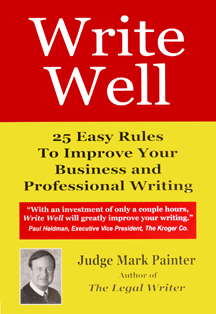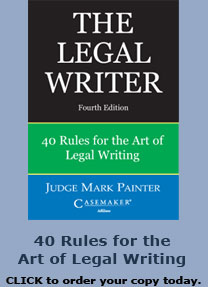The Legal Writer #28: Organization And Writing – Not At Same Time
By Judge Mark P. Painter
|
Should you organize your writing before or after doing it? That is, should you make a detailed outline of what you want to communicate, and then fill in the outline with writing? Or should you just sit down and write what comes, and organize it later? That is, start writing the text, and then later put in headings, move text around, and generally impose organization? My answer: either way. You should do whatever works for you. But don’t try to do both at once. If you write a couple of paragraphs, then impose a structure on them — perhaps by moving them to different sections of your document, or by trying to think up headings for what you just wrote — your task will be harder. Brainsides Why is it harder to mix organization and creativity? Because your brain will rebel — it might even freeze up. Organization is a left-brain activity, mainly controlled by the left half of your brain. Writing is a creative task, mainly controlled by the right side of your brain. Switching back and forth between the two halves sets up a ping-pong match inside your head. Try changing gears too often, or switching windows too fast on your PC, and see what happens. Fiction is what is often called “creative writing.” But all writing is “creative” in that you are forming ideas into words, sentences, and paragraphs. So separate the two functions. My solution: if I have an idea for a column, I just start writing. Usually it’s on the PC, but sometimes it’s in longhand if I am not in the office. I write until I run out of things to say. Then later — maybe even a few days later — I type it in if in longhand, then organize and edit it. Headings need to be added. Since a first draft is not the place to worry about grammar and syntax, much editing is necessary. Paragraphs may need moving, and separating — newspaper writing calls for shorter paragraphs. For other writing, my process is similar. Of course, for opinions, I have law clerks to do a first draft (surprise!), which includes the basic structure. Then I tinker and edit. Other writers do an outline first. Outlines have never been my forte (pronounced fort by the way). But outlines are excellent tools for some — if they work for you, use them. But don’t try to impose organization at the same time you are trying to be creative. Remember that they are two separate tasks — and you will tax your brain to do both together. Trying to combine them is the cause of “writer‘s block.” Remember to Question Questions on usage, style, or grammar are welcome. I’m not a grammarian, but I have a lot of sources. Please send questions, comments, or particularly good or bad examples of legal writing to jugpainter@aol.com. Readability In each column, I list the two major readability statistics — remember that you can program Word to tell you these and more. Statistics for this column: 13 words per sentence, 5 percent passive voice. (Remember the 1818 Rule — no more than an average of 18 words per sentence and 18 percent passive-voice sentences.)
|
____________________________________
Mark Painter is a judge on Ohio First District Court of Appeals and an Adjunct Professor at the University of Cincinnati College of Law. He is the author of five books, including The Legal Writer 2nd Ed.: 40 Rules for the Art of Legal Writing. The book is available at the Ohio Bookstore in Cincinnati, Joseph-Beth Booksellers in Cincinnati and Cleveland, the Book Loft in Columbus, and from Lawyers Weekly Books at http://books.lawyersweekly.com. Judge Painter has given more than three dozen seminars on legal writing. Contact him through his website at www.judgepainter.org.








